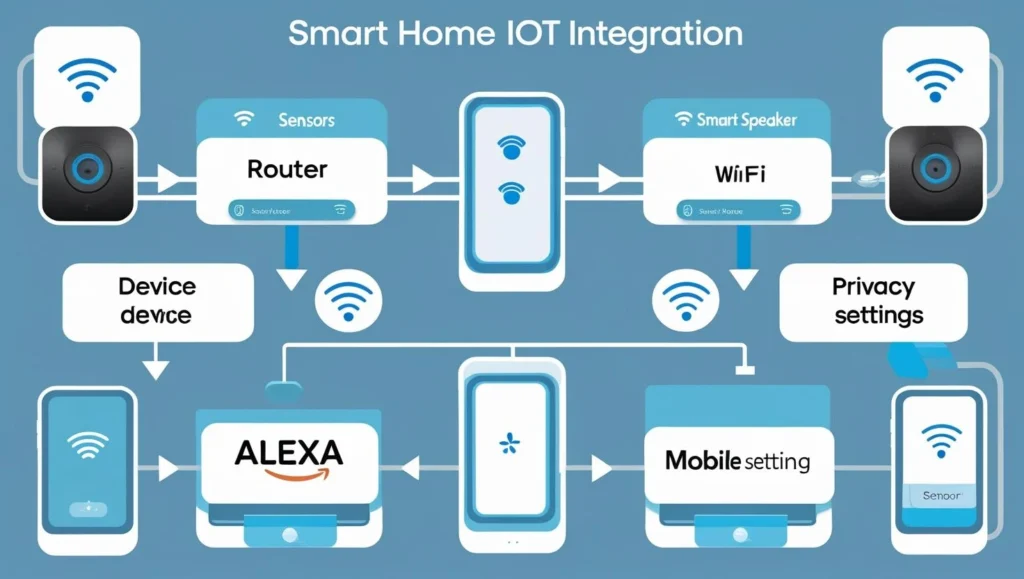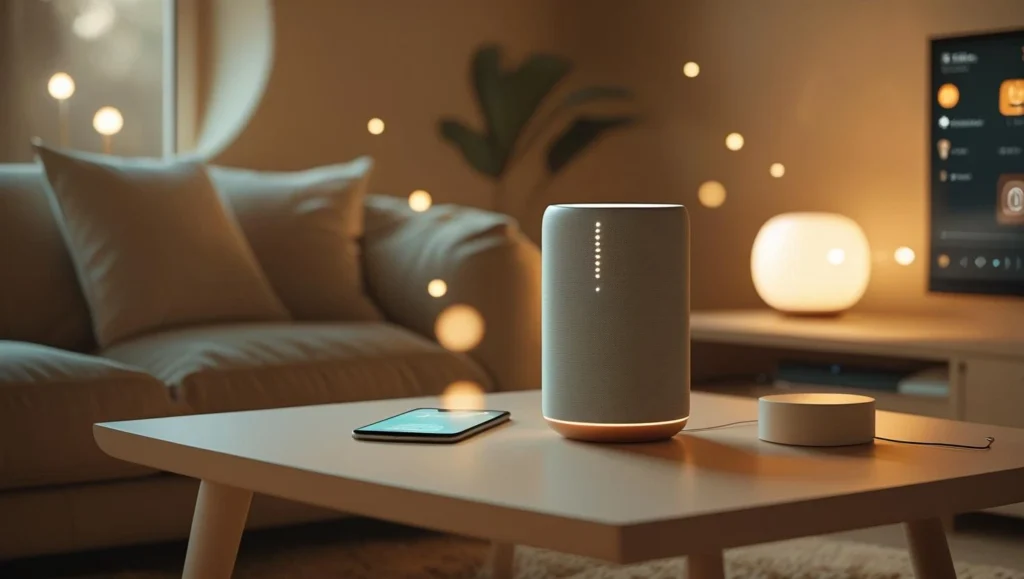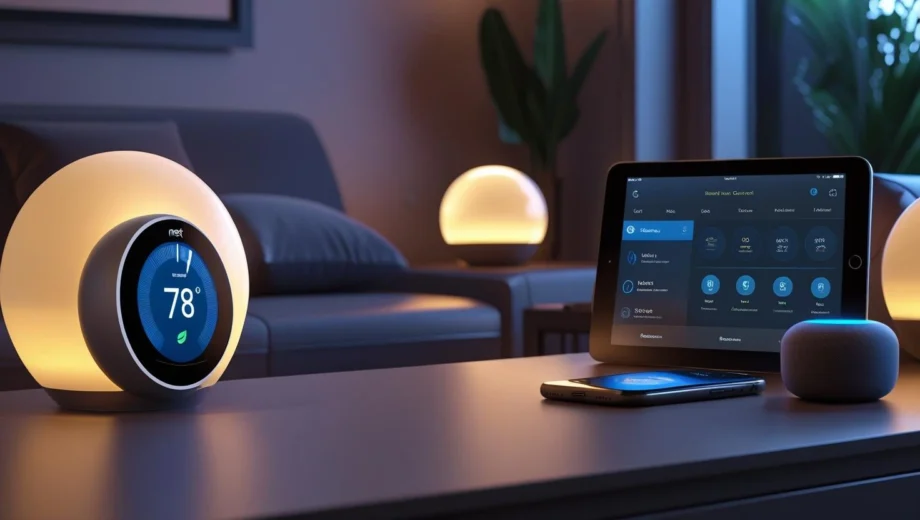Introduction
The smart home revolution is accelerating across the USA and UK, fueled by growing consumer interest and widespread broadband access. With more than 50% of households planning to adopt IoT devices by 2025, the shift from novelty to necessity has begun. Homeowners now expect seamless control of lighting, security, energy, and climate—all from their smartphone or voice assistant.
At the heart of this transition is the Internet of Things (IoT). By embedding sensors, WiFi-controlled devices, and intelligent platforms, IoT transforms ordinary homes into proactive, efficient ecosystems. This requires more than purchasing gadgets—it requires a clear Smart home IoT roadmap 2025 that ensures compatibility, security, and future-proof scalability.
This article outlines a complete roadmap: from planning and budgeting, connectivity setup, device integration, and security, to exploring voice-control platforms like Amazon Echo. It will also guide you through purchasing strategies with a “Buy IoT devices” focus, leveraging community support from SmartThings forums, and adapting solutions to regional factors. Finally, you’ll glimpse the future beyond 2025, where AI-driven automation and ambient computing take center stage.Browse the full range of Amazon Echo devices on the official store.
Why Smart Homes Need a Roadmap

A smart home IoT roadmap 2025 is essential because modern smart homes are complex ecosystems with multiple devices and protocols. When asking, “How to set up smart homes?”, the answer starts with thoughtful planning.Learn how the Matter protocol is creating seamless smart home compatibility.
Common Challenges:
- Compatibility: Devices span WiFi, Zigbee, Z-Wave, and new standards like Matter—ensuring interoperability is crucial.
- Connectivity: A single router often falls short; mesh networks are increasingly necessary for full coverage.
- Security & Privacy: IoT devices can be an attack vector—encryption, firmware updates, and local storage are vital.
- Smart voice assistant integration: Ensuring devices respond reliably to voice commands across different brands.
Without a roadmap, homeowners risk device conflicts, fragmented control apps, and vulnerable setups. A strategic approach ensures each layer of your home ecosystem works together securely and harmoniously.
Smart Home IoT Roadmap 2025
a. Planning and Budgeting
Start with clear goals:
- Security needs: Smart locks, cameras, video doorbells
- Lighting & ambiance: Smart bulbs and switches
- Climate control: Thermostats and smart vents
- Automation & convenience: Timers, health sensors, chore-based routines
Organize your budget in phases:
| Phase | Devices | Estimated Cost (USD) |
|---|---|---|
| Phase 1 | Router/mesh, Amazon Echo, 2 sensors | $400–600 |
| Phase 2 | Smart lighting, thermostat, doorbell | $700–1,200 |
| Phase 3 | Smart security suite, plugs | $1,000+ |
b. Connectivity Infrastructure
IoT systems rely on a strong network backbone:
- Mesh WiFi routers (e.g., Eero, Google Nest) ensure whole-home coverage.
- Protocols like Zigbee, Z-Wave, and the new Matter standard enable seamless device integration.
- Ensure your central hub (SmartThings, HomeKit) or voice assistant supports Matter to prevent future compatibility issues.
c. Device Selection & Integration
Choose high-quality devices compatible with Alexa and Matter:
- Amazon Echo: Central hub with voice control; supports Alexa routines.
- Sensors: Motion, door/window, temperature sensors.
- Smart plugs and outlets: Enable device automation and energy tracking.
- Cameras: Indoor/outdoor with dual storage (local + cloud).
- Smart thermostats: Nest, Ecobee, or Honeywell.
Use centralized control via the SmartThings hub or Apple HomeKit. Control individual gadgets via Amazon Alexa app, Google Home, or SmartThings app.
d. Mobile Apps & Control Panels
Unify smart home control through apps:
- SmartThings app: Compelling dashboards, automation rules, device health tracking.
- Alexa app: Voice-driven routines and compatible third-party skills.
- Google Home: Easy onboarding for Android users.
- Ensure apps sync across your phone, tablet, and smart displays to avoid fragmented control.
e. Privacy, Security & Data Management
A trusted smart home requires proactive security:
- Update firmware, change default passwords, enable device encryption.
- Set up separate VLANs or guest networks for IoT devices to isolate them from PCs.
- Choose devices supporting local data storage to avoid privacy risks tied to unwanted cloud access.
Buy IoT Devices: What to Look For
When you Buy IoT devices, quality matters more than quantity:
- Compatibility: Confirm official support for Matter or Alexa.
- Security protocols: Prioritize devices with TLS encryption and regular updates.
- Reviews & forums: Narrow down best options by checking retailer reviews and discussions on Reddit or SmartThings forums.
- Automation capabilities: Look for routines, energy logging, and integration with voice assistants.
Major retailers like Amazon, BestBuy, and specialty hubs like SmartHome are reliable sources. Utilize trial periods or starter kits to validate device ecosystems before larger investments.
Alexa and Amazon Echo: Central to Smart Homes

Amazon Echo devices—Echo Smart Speaker, Echo Show—act as the nerve center of a smart home:
- Alexa voices routines: “Good morning” sequence can adjust thermostats, lights, and news briefings.
- Skill integrations: Add third-party smart device controls—think Philips Hue, Ring, and Sonos.
- Multi-room audio & announcements: Use Echo Show for visual feedback during routines (e.g., doorbell announcements).
- Edge processing: Improve privacy with Echo's local voice processing and data caching.
Echo’s unmatched developer ecosystem ensures it integrates broadly and remains future-proof for evolving smart home setups.
Navigating SmartThings Forums & Online Support
The SmartThings forums are a treasure trove of DIY advice:
- Troubleshoot device pairing or firmware issues.
- Access user-created routines and webhooks for custom automation.
- Stay updated on Samsung’s integrations and Matter compatibility.
Sign up for topics like “HomeKit to SmartThings bridging” or “Nest to Alexa automation.” Community-driven Q&A helps enhance usability and resilience of your setup.
Geo Insights: USA & UK Adoption Patterns
Smart home trends differ between the USA and UK:
- USA: Broad broadband access allows large-scale adoption; Alexa leads voice assistant usage. Homeowners favor smart energy solutions tied to sustainability incentives.
- UK: Matter adoption is growing faster thanks to energy-saving regulations. Data privacy (GDPR) encourages favoring local smart-hub storage over cloud.
Regional differences influence smart device pricing, availability, and consumer preferences. Planning your roadmap while considering local regulations and broadband realities ensures a smoother rollout.
The Future of Smart Homes Beyond 2025
Looking ahead:
- AI-enhanced automation: Smart appliances autonomously adapt using pattern recognition and behavioral learning.
- Predictive analytics: Fridge restocks before you notice; energy-usage optimization reduces bills.
- Ambient computing: Sensors detect occupancy and adjust habitually without manual prompts.
- Smart energy ecosystems: Homes function as mini-grids with EV chargers, solar, and community load sharing.
- Home robotics: Cleaning bots and compact assistants become routine.
- Sustainability: Open sensor platforms (via IoT-for-good initiatives) support efficiency and carbon tracking.
Homes are evolving into dynamic, green, intuitive environments, fully connected and streamlined by 2030.
Explore how blockchain is evolving alongside smart home tech in our Blockchain Development Roadmap 2025.
Conclusion
A successful smart home experience hinges on a solid Smart home IoT roadmap 2025: plan needs and budget, design a robust connectivity framework, integrate devices like Amazon Echo and sensors, secure your network, and rely on user-friendly apps. Take advantage of community insights from SmartThings forums and shop wisely when you Buy IoT devices.
This year, the smart home market continues to expand—powered by AI, sustainable energy platforms, and user-centric digital living. By adopting this roadmap, homeowners in the USA, UK, and beyond can build smart, secure, and future-ready environments tailored to their lifestyles.
Start exploring SmartThings forums, evaluate Amazon Echo ecosystems, and begin mapping out your own intelligent home journey—your connected household of the future starts now.







